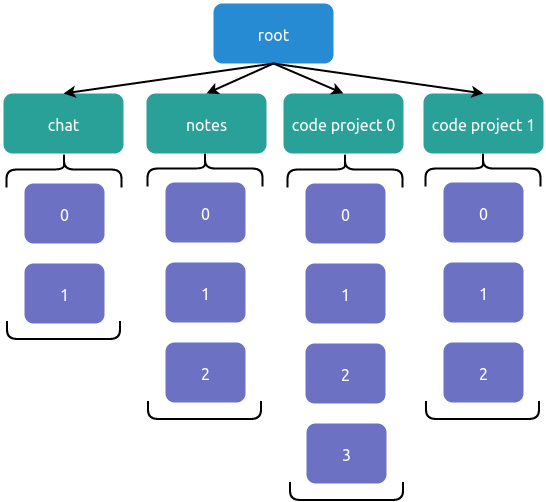Metadesk is a bspwm wrapper that organizes your desktops into a tree. This is useful for grouping related desktops together to, for instance, separate different tasks. Some features:
- Construct and navigate an arbitrary tree of desktops
- Automatically append and remove empty subdesktops
- Add arbitrary string attributes to desktops, such as names or working directories
- Subscribe to state changes, ready to pipe to status bars like lemonbar
You'll first need to set up go and bspwm. Then run:
$ go get github.com/alexozer/metadesk/...
Similar to bspwm, metadesk uses a client-server model to control its state. A metadesk daemon, started with the metadesk command, is controlled using the mdc command. To control metadesk using hotkeys, you use a hotkey daemon like sxhkd to call mdc.
mdc DESKTOP_SEL COMMAND
mdc applies the given command to the given selected desktop.
A DESKTOP_SEL consists of an initial desktop selection and any number of subselectors:
<initial_sel> [SUBSELECTOR]*
<inital_sel> can be any of:
rootthe root desktopfocusedthe currently focused leaf desktoplastthe most recently focused leaf desktop
A subselector can be any of:
-p | --parentselect the parent of the currently selected desktop-c | --child <n>select the child desktop at index n
Once a desktop is selected, a command is provided to act on the desktop.
| Command | Description |
|---|---|
| `-f | --focus` |
| `-n | --next` |
| `-p | --prev` |
| `-a | --add` |
| `-r | --remove` |
| `-A | --attrib ` |
| `-A | --attrib <name ` |
| `-u | --unset ` |
| `-w | --move-window` |
| `-s | --swap ` |
| `-F | --focused-child` |
| `-C | --child-count` |
| `-P | --print ` |
| `-S | --subscribe ` |
Formatters are small functions which format the state of a desktop as a string. The --print and --subscribe command take a formatter name as an argument. By default, metadesk includes a tree formatter which recursively prints the state of all desktops, and a lemonbar formatter which formats the children of the root desktop for lemonbar. To create your own formatter, you can fork this repository and implement the server.Formatter interface.
Attributes are user-defined string key-value pairs stored in desktops. They can be accessed by mdc and formatters. For example, the default lemonbar formatter prints the name attribute of the root desktop's children.
You could use attributes to:
- Store the current working directory of the desktop and open all new terminal windows in this directory
- Store a color string for a formatter to use to output to a panel
- Store some personal notes
A sample metadesk configuration which uses sxhkd and lemonbar is available in the examples directory.
Focus the second child of the root desktop:
mdc root -c 1 -f
Select the desktop next to the focused desktop:
mdc focused -p -n
Set the "cwd" attribute of the third child of the root desktop:
mdc root -c 2 -A cwd "$HOME/code"
Remove the last focused desktop:
mdc last -r
Continuously pipe the root desktop's state to lemonbar:
mdc root -S lemonbar | lemonbar
Please do! Pull requests are welcome.
Here are some possible extensions to work on:
- Selectors to select sibling desktops
- Attribute-based desktop selectors
- Multihead support
- React to external desktop focusing
- Additional example formatters
